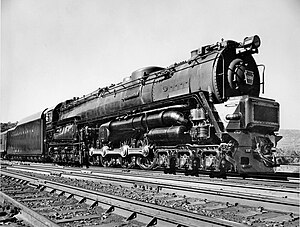
Under the Whyte notation for the classification of steam locomotives, a 2-10-4 locomotive has two leading wheels on one axle, usually in a Bissel truck, ten coupled driving wheels on five axles, and four trailing wheels on two axles, usually in a bogie. These were referred to as the Texas type in most of the United States, the Colorado type on the Burlington Route, and the Selkirk type in Canada.
Under the Whyte notation for the classification of steam locomotives, 2-10-0 represents the wheel arrangement of two leading wheels on one axle, ten powered and coupled driving wheels on five axles, and no trailing wheels. This arrangement was often named Decapod, especially in the United States, although this name was sometimes applied to locomotives of 0-10-0 "Ten-Coupled" arrangement, particularly in the United Kingdom. Notable German locomotives of this type include the war locomotives of Class 52.
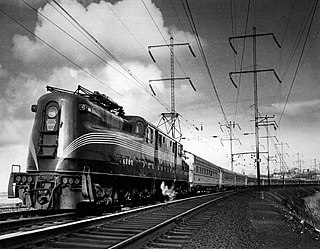
The Pennsylvania Railroad GG1 is a class of streamlined electric locomotives built for the Pennsylvania Railroad (PRR), in the northeastern United States. The class was known for its striking art deco shell, its ability to pull trains at up to 100 mph, and its long operating career of almost 50 years.

This article is a glossary of the main components found on a typical steam locomotive.

The Pennsylvania Railroad (PRR) K4 4-6-2 "Pacific" was its premier passenger-hauling steam locomotive from 1914 through the end of steam on the PRR in 1957.
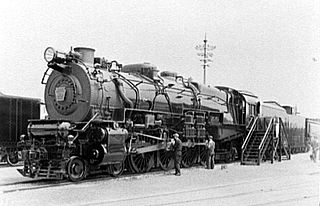
The M1 was a class of steam locomotive of the Pennsylvania Railroad (PRR). It was a class of heavy mixed-traffic locomotives of the 4-8-2 "Mountain" arrangement, which uses four pairs of driving wheels with a four-wheel guiding truck in front for stability at speed and a two-wheel trailing truck to support the large firebox needed for sustained power. Although built for both passenger and freight work, they spent most of their service lives hauling heavy high-speed freight trains. Many PRR men counted the M1 class locomotives as the best steam locomotives the railroad ever owned.

A 6-4-4-6 steam locomotive, in the Whyte notation for describing locomotive wheel arrangements, is one with six leading wheels, two sets of four driving wheels, and six trailing wheels.
The Pennsylvania Railroad's class K5 was an experimental 4-6-2 "Pacific" type, built in 1929 to see if a larger Pacific than the standard K4s was worthwhile. Two prototypes were built, #5698 at the PRR's own Altoona Works, and #5699 by the Baldwin Locomotive Works. Although classified identically, the two locomotives differed in many aspects, as detailed below. They were both fitted with a much fatter boiler than the K4s, but dimensionally similar to those of the I1s 2-10-0 "Decapods". Most other dimensions were enlarged over the K4s as well; the exceptions being the 70 square feet (6.5 m2) grate area and the 80 in (2.032 m) drivers.

The PRR S1 class steam locomotive was a single experimental duplex locomotive of the Pennsylvania Railroad. It was designed to demonstrate the advantages of duplex drives espoused by Baldwin Chief Engineer Ralph P. Johnson. It was the longest and heaviest rigid frame reciprocating steam locomotive that was ever built. The streamlined Art Deco styled shell of the locomotive was designed by Raymond Loewy.

A steam turbine locomotive is a steam locomotive which transmits steam power to the wheels via a steam turbine. Numerous attempts at this type of locomotive were made, mostly without success. In the 1930s this type of locomotive was seen as a way both to revitalize steam power and challenge the diesel locomotives then being introduced.
The Pennsylvania Railroad's class P5 comprised 92 mixed-traffic electric locomotives constructed 1931–1935 by the PRR, Westinghouse and General Electric. Although the original intention was that they work many passenger trains, the success of the GG1 locomotives meant that the P5 class were mostly used on freight. A single survivor, prototype #4700, is at the National Museum of Transportation in St Louis, Missouri.

The Pennsylvania Railroad's class O1 comprised eight experimental boxcab electric locomotives built in 1930 and 1931. They were built in preparation for the New York to Washington Electrification project. They had the wheel arrangement classified as 4-4-4 in the Whyte notation. Although successful, they were not powerful enough for the railroad's increasingly heavy trains. For production, the PRR chose to concentrate on the P5 class, effectively an enlarged and more powerful version of the O1 with an additional pair of driving wheels.
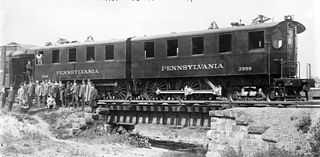
The Pennsylvania Railroad DD1 was a class of boxcab electric locomotives built by the Pennsylvania Railroad. The locomotives were developed as part of the railroad's New York Tunnel Extension, which built the original Pennsylvania Station in New York City and linked it to New Jersey via the North River Tunnels. The Pennsylvania built a total of 66 locomotives in its Altoona Works; they operated in semi-permanently coupled pairs. Westinghouse supplied the electrical equipment.

The Pennsylvania Railroad's class DD2 was a single prototype electric locomotive never placed into series production. It was intended as an improved and simplified GG1 for use on the planned, but never built, extension of the PRR's electrification west of Harrisburg, Pennsylvania. The one locomotive produced was numbered #5800 and used in regular Baltimore tunnel helper service until it was scrapped in September 1962.
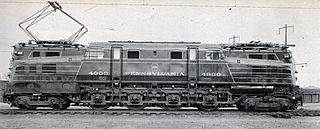
The Pennsylvania Railroad's class R1 comprised a single prototype electric locomotive constructed in 1934 by the Baldwin Locomotive Works of Philadelphia, Pennsylvania, USA, with the electrical equipment by Westinghouse.

The Pennsylvania Railroad's class L5 were the railroad's second generation of production electric locomotives after the DD1, and the last to use a jackshaft and side rods to drive the wheels. The L5 was a single-unit locomotive instead of the twin-unit DD1. The wheel arrangement in Whyte notation was 2-4-4-2, or 1-B-B-1 in the AAR scheme. Twenty five were built in 4 distinct subclasses. The lead unit of the class was equipped for AC operation with an overhead pantograph, while the other 24 were third rail DC units to work on the existing PRR third rail electrification in the New York area.
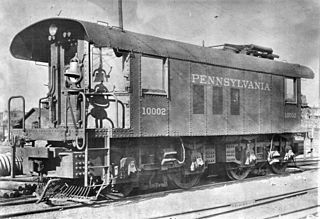
The Pennsylvania Railroad's class AA1 comprised two experimental electric locomotives constructed in 1905 by the company's own Altoona Works with the assistance of Westinghouse. Intended as testbeds as the PRR began its electrification project, both locomotives remained service into the 1930s.

The GE E60 is a family of six-axle 6,000 hp (4.5 MW) C-C electric locomotives made by GE Transportation Systems (GE) between 1972 and 1983. The E60s were produced in several variants for both freight and passenger use in the United States and Mexico. GE designed the locomotive for use on the Black Mesa and Lake Powell Railroad (BM&LP), a dedicated coal-hauling route in Arizona, which began operation in 1973. That same year GE adapted the design for high-speed passenger service on Amtrak's Northeast Corridor. The largest customer was Ferrocarriles Nacionales de México (NdeM), the state-owned railroad in Mexico, which bought 39 for a new electrification project in the early 1980s.
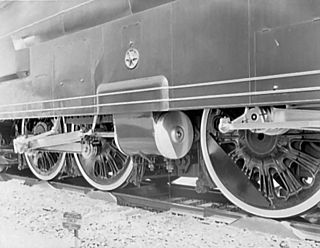
A duplex locomotive is a steam locomotive that divides the driving force on its wheels by using two pairs of cylinders rigidly mounted to a single locomotive frame; it is not an articulated locomotive. The concept was first used in France in 1863, but was particularly developed in the early 1930s by the Baldwin Locomotive Works, the largest commercial builder of steam locomotives in North America, under the supervision of its then chief engineer, Ralph P. Johnson.

Pennsylvania Railroad 5550 is a mainline duplex drive steam locomotive under construction in the United States. With an estimated completion by 2030, the locomotive will become the 53rd example of the Pennsylvania Railroad's T1 steam locomotive class and the only operational locomotive of its type. The estimated cost of PRR 5550 was originally $10 million, but an updated projected cost of $7 million was released with the acquisition of an existing long-haul tender from the Western New York Railway Historical Society in August 2017. Construction began in 2014 with the casting of the locomotive's keystone-shaped number plate. Major components, including two Boxpok drivers, the prow, the cab, third-course boiler, and fire door have been completed.
